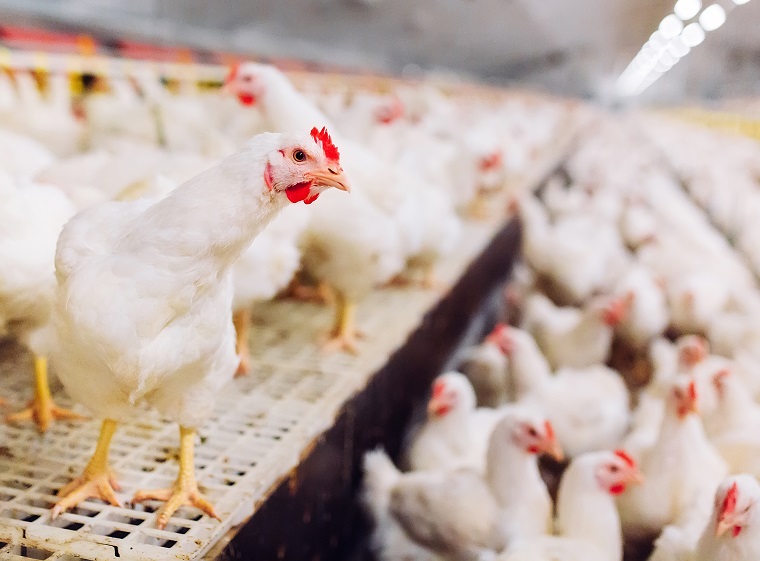You Are What You Eat, but What Should Your Food Eat? Feed-additive Benefits in an Antibiotic-free Future
By Michael Lim
24 January 2020

Growing concerns about antibiotic use in livestock production by both the scientific community and the general public have led to a major push to reduce or eliminate antibiotic use on farms. With the future of this once common production tool now in question, producers and animal scientists are seeking new ways to get food from farm to market both sustainably and affordably. Prof. David Wright from the Department of Human Health and Nutritional Sciences and Dr. Leslie McKnight from Trouw Nutrition Canada recently teamed up to discover what may be a promising way to produce healthy broiler chickens without the use of in-feed antibiotics: vaccination combined with feed additives that promote gut health.
To meet increasing consumer demand and keep meat affordable, producers try to grow large numbers of chickens as efficiently as possible. Historically, this has included administering antibiotics to chickens through food and/or water to prevent disease. Without this protection, parasites such as coccidiosis and other bacterial diseases can lead to damaged gastrointestinal tracts, reducing the growth and survival of chicks, and increasing feed costs.
One potential alternative to antibiotics is vaccination, a proven method of inducing a better immune response to infection. However, it can also lead to inflammation of the gut and reduced feed efficiency (in other words, more feed must be consumed to gain the same body mass). To combat these negative side effects, feed additives (FAs) such as prebiotics, probiotics, and enzymes could help support gut integrity and function, potentially reducing the short-term impacts of vaccination.
To test this theory, McKnight raised coccidiosis-vaccinated chickens from hatch until they were 36 days old (when most chicken are slaughtered for consumption) with either unmodified feed, feed with FAs, or feed supplemented with an antibiotic. Over the course of the chickens’ growth, she and her colleagues assessed several factors including changes to gut morphology and feed efficiency.
To better understand the impact of FAs and vaccination at the cellular level, McKnight - a University of Guelph alumna - reached out to Wright. Although Wright’s research is primarily focused on the impacts of diabetes, exercise, and pharmaceuticals on human health, McKnight realized that Wright had the right expertise to help characterize the impacts of feed on gut health in chickens. This led Wright and PhD student Willem Peppler to identify the expression of genes responsible for triggering inflammation in the gut, to complement the intestine and whole-body research being carried out by McKnight.
“I think getting to work with industry is a really good experience. It really exposes you to a new facet of research,” says Wright. “If you told me five years ago that I’d get into chicken gut research, I’d say you were absolutely crazy. But researchers tend to pigeonhole themselves, which can set limits on their research.”
The team found that both FA and antibiotic feeds significantly altered the length of villi in the intestine (villi are the small finger-like projections that make up the intestinal surface). Both treatments also caused significant changes in the expression of inflammation genes, and decreased feed efficiency midway through the experiment. Interestingly, chickens fed with FAs had significantly fewer markers of gut damage and inflammation than chickens who received the antibiotic feed, but were not significantly different from chickens fed normal feed. Reductions in feed efficiency midway through the experiment were not as severe as for chickens fed antibiotics, and FA-fed chickens showed increased feed efficiency early in life compared to chickens grown with antibiotic feed or even feed without additives. Regardless of feed type, however, by day 36 there were no differences in feed efficiency between the different feed treatments.
In other words, vaccinated chickens fed with FAs appear to experience an inflammatory response, but not as severe as chickens fed antibiotics. And although there is likely a diversion of energy away from growth toward an immune response, this effect is only temporary as chickens fed FAs were able to recover to normal levels by the time they reached market weight.
McKnight and Wright believe that their results can help to inform researchers and producers about a viable alternative to antibiotic feeds. The study marks their first joint foray into the field of poultry gut health, and they hope to follow up with additional collaborative studies on other markers of inflammation, and to characterize specific changes in immune function.
“With increased pressure to reduce or eliminate antibiotic use, there’s a big change coming for the industry,” says McKnight. “This study provides some really nice support that chickens can still grow well without antibiotics in their feed, and as more work continues on the development of feed additives and other technologies, it could really help producers boost animal health and growth performance in the future.”
Other major collaborators for this research include Drs. Greg Page and Yanming Han (Trouw Nutrition Canada) and Drs. Ryan Synder and John Barta (University of Guelph). Funding for this research was provided by Trouw Nutrition Canada and the Natural Sciences and Engineering Research Council.
Read the full article in Poultry Science.
Read about other CBS Research Highlights.